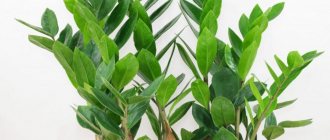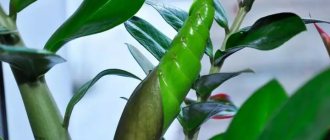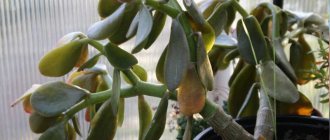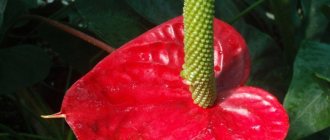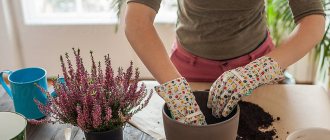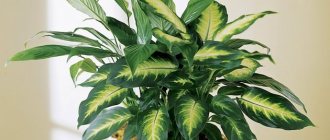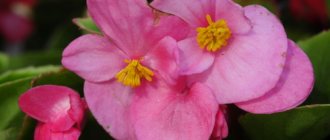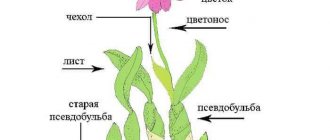Friends, I recently encountered an unpleasant problem. It grew, so I had a pepper on the windowsill, and then its foliage began to turn yellow and fall off. I started looking for information about why the pepper leaves on the windowsill turn yellow. I discovered several reasons and ways to combat it, and I’ll share this with you.
First the leaves turn yellow and then begin to dry out.
What is the danger of pepper seedlings falling leaves?
Leaves are not decoration, but the most important organ through which the process of photosynthesis and nutrition of the plant takes place. The loss of leaves leads to disruption of biochemical processes and rapid weakening of the plant organism.
Falling leaves at the seedling stage is dangerous in the short and long term because:
- leafless pepper seedlings risk dying;
- Even having avoided death and returned to growth, the seedlings become less viable and less productive in the future.
How to save pepper
As soon as you see that the leaves are falling off, follow the recommendations:
- Treat the pepper with Zircon - the immunomodulator will help it cope with a stressful situation.
- Determine the cause of leaf falling.
- Eliminate it.
- If leaf fall is caused by an incurable disease, immediately remove and burn all affected bushes. Treat healthy plantings with any complex fungicide (Gamair, Planriz, Baktofit, Oksikhom).
- Errors in care are easier to correct - water with warm water, replant in the right soil, feed with the missing element.
- The challenges of changeable weather can be predicted by knowing the nearest forecast. It is better to plant seedlings after May 20. If it gets cold in June, cover the seedlings with lutrasil at night.
Causes of falling and solution to the problem
Pepper seedlings are demanding and capricious, so there are many reasons why “leaf fall” may begin. Basically, they are all associated with violation of growing conditions and agrotechnical errors.
Bad light
Lighting errors can occur in any place - both on window sills and in specialized greenhouses. The main problem is the lack of light, which light-loving peppers have a very high need for.
Favorable light conditions for pepper:
- at least 12 hours of daylight;
- diffused type of lighting.
If the pepper lacks light, it begins to shed its leaves. In addition, plants stretch, their trunks become thin and fragile.
Measures to prevent lack of light:
- turning on phytolamps with a power of 40-80 W (lamps are placed 8-10 cm above the plants);
- planting seeds in accordance with the scheme, maintaining intervals of 1-1.5 cm between neighboring plants, otherwise the plantings will be thickened;
- Instead of phytolamps, you can use natural lighting, placing boxes with seedlings on the sunniest balconies and window sills.
If the seedlings are positioned in such a way that direct sunlight falls on them, they must be shaded periodically - from 11 a.m. to 2 p.m. Otherwise, the leaves will get sunburned.
Incorrect soil composition
Pepper seedlings cannot be grown in ordinary soil; a special substrate is prepared or purchased for it.
Optimal composition:
- humus - 2 parts;
- calcined earth - 1 part;
- sand - 1 part.
The soil must have neutral acidity. If the soil is acidic, you need to add dolomite flour - 200 g per 1 square meter. m.
Fertilizer shortage
Insufficiently nutritious soil is one of the most common causes of leaf falling. Sowing is done in fertile soil, purchased or prepared independently. At first, the seedlings grow quickly, but over time the soil becomes depleted and the plants experience a lack of nutrition.
If the leaves turn yellow and fall off, the pepper seedlings are most likely lacking nitrogen. In order to develop fully, the upper part of the plant takes nutrition from the lower leaves, because of this they gradually die off.
How to eliminate nutritional deficiencies:
- If the leaves are yellow. Feed the seedlings with fertilizers containing nitrogen - you can use urea or saltpeter (20 g per 1 sq. m).
- If the leaves have turned yellow, but the veins remain green. This means there is not enough calcium. Apply any complex fertilizer according to the instructions.
Feed the seedlings at the root, and only on damp soil, so as not to burn the tender roots of the plants. Do not water the peppers for the next couple of days, otherwise the water will wash the nutrients through the drainage holes.
Wrong choice of container
To prevent leaves from falling off, seedlings should grow in containers measuring 8x12-15 cm (height x diameter). If this rule is violated, plus if the plantings are dense, the roots of the plants become intertwined and the growth of young plants is inhibited.
Wrong pick
Picking involves replanting plants by pinching the roots, which is a significant stress for them. It is important to move the seedlings carefully, otherwise one of the reactions to it will be the dropping of leaves.
How to prevent leaves from falling:
- immediately sow pepper seedlings in separate containers so as not to replant;
- it is best to sow peppers in peat pots, then the seedlings will not have to be removed from the containers at all, even when transplanted to a permanent place;
- if sowing is done in a common container, observe the intervals provided for by agricultural technology, otherwise the roots of the plants will intertwine and tear when picking;
- For 3-4 days after transplanting into new containers, the seedlings are kept in a dark place; if you place them in the sun, the leaves will begin to dry out and fall off.
Low temperature
Pepper comes from warm countries, so it is very heat-loving. Cannot tolerate cold and drafts. For normal growth and development, it needs a daytime temperature in the range of +22...+25°C, and a nighttime temperature not lower than +14°C.
Cold weather causes seedlings to weaken and lose their ability to extract nutrients from the soil. The only tool for obtaining the latter are leaves. Experiencing critical overload, the pepper foliage gradually turns yellow and falls off.
It is important to maintain the temperature in the greenhouse or other room in which the seedlings are growing within the established limits. After planting seedlings in closed ground, if the need arises, it is recommended to turn on the heaters.
Improper watering
Pepper loves not only light and warmth, but also watering. It reacts equally negatively to both waterlogging and moisture deficiency. The leaves of the plants wither, become soft and drooping, and after a while they turn yellow and fall off.
Pepper has a shallow but branched root system, so the plant takes water mainly from the top layer of soil. It is recommended to water this crop frequently and abundantly.
How to properly water pepper seedlings:
- the water should stand for two days;
- water temperature for irrigation - +20....+22°C;
- Containers must have drainage holes to ensure the drainage of excess water;
- watering is carried out only after the soil has dried by 2 cm, no less;
- It is advisable to water in the morning;
- water is poured directly under the roots so that it does not fall on the leaves - otherwise sunburn may occur.
If you pour cold water over the pepper, the temperature in the container will change sharply, and the roots will lose their ability to “drink.” Because of this, watered plants will need water, despite the moist soil.
Crop rotation violation
“Leaf fall” in seedlings can be observed due to violation of crop rotation rules. There are crops after which pepper cannot be grown. Inexperienced gardeners often make a grave mistake - they take garden soil from an area where crops unfavorable for peppers grew and forget to treat it before sowing.
Unfavorable predecessors for pepper are all nightshade crops - potatoes, eggplants, tomatoes.
Diseases and pests
Falling leaves on seedlings can be caused by certain diseases and pests. Such cases are the most dangerous, since the loss of leaves occurs after a long and destructive impact of negative factors.
Causes of leaf falling:
- Spider mite. Small sucking insects that settle on the underside of leaves. Damaged leaves curl and fall. To combat ticks, use “Akarin” or “Fitoverm”, in accordance with the dosage specified by the manufacturer. If the case is not advanced, you can limit yourself to a soap solution - a piece of grated soap in 10 liters of water. In particularly advanced cases, it is recommended to spray the seedlings with Actellik.
- Aphid. Settles on all above-ground parts of the plant. The leaves become pale yellow and gradually fall off the seedlings. It is recommended to spray the seedlings with tincture of tobacco dust - dilute 500 g in 10 liters of water and leave for 24 hours. Then add 50 g of laundry soap. Wood ash will also be used instead of tobacco.
- Fusarium wilt. This is a common disease among nightshade crops. Causes rapid yellowing and falling of leaves. The causative agent is a fungus, which makes no sense to fight at the stage of growing seedlings. If bright yellow leaves appear on the seedlings, they need to be torn out and destroyed, and the entire soil should be calcined or disinfected with a solution of Fundazol.
- Stolbur is a pathological condition caused by microscopic midges that drink juices from leaves and other parts of plants. Seedlings slow down, their foliage turns yellow and subsequently falls off. They fight the problem with chemicals. Even before flowering, all seedlings must be treated with insecticides - “Aktara”, “Inta Vir”, “Aktellik”, “Confidor” or their analogues.
- Late blight . The disease often affects young plants. Before falling, it causes characteristic spots on the leaves - dark and dense. The problem is dealt with using the drugs “Barrier” or “Barrier”. They are also recommended for use in cases of blackleg. This disease, common in seedlings, is easily recognized by the dark ring at the base of the stem.
Other vegetable diseases, such as powdery mildew, can also cause leaf loss. Having discovered signs of a particular disease, you must immediately take measures to treat or destroy the seedlings - if the pathology is incurable.
Pepper - plant of the sun
The decorative value of indoor peppers is not at all in the flowers, which look very much like tomato, potato, or nightshade flowers. It’s not for nothing that all these fruiting plants are part of the vast nightshade family! What makes it especially attractive are the fruits: bright, as if lacquered, in all the colors of the rainbow, they flaunt on one plant, like toys on a Christmas tree. It’s not for nothing that indoor peppers are often called Christmas peppers!
In color they are green, red, yellow, orange, purple and even white. It depends on the variety and degree of ripeness. It is interesting that one bush can be decorated with barely set fruits, already half ripe and completely ripe. They also vary in shape: round, oval, bell-like, or cones, some hanging down, others pointing upward, like candles.
photo by the author
Note: All fruits, regardless of color, are edible. But be careful, this pepper is for those who like it spicy! Moreover, on one plant, green fruits may have a subtle tang, but red fruits will have an “eye-catching” taste.
The decorative pepper we are familiar with came from a Mexican capsicum. The name of this species, capsicum annuum, comes from the Greek word "kapto", which means "to bite" and primarily refers to the pungency of the "biting" fruit. By the way, the substance that causes this pungency is called capsicin! The second word in the name “annuum” translated from Latin means “one-year-old”, which is actually wrong. After all, indoor hot peppers in suitable conditions can bloom and bear fruit for 5-6 years.
Golden Horn
Aladdin
Fireworks
In its homeland, Mexico, Guatemala and Cuba, pepper grows into a lush evergreen shrub up to 1 meter high. To the delight of flower growers, there are currently many varieties with a compact bush no more than 50 cm in height and miniature fruits up to 10 cm in length. Typically, such varietal peppers are prepared in advance for all indoor deprivations. Depending on the variety, the taste will be different: from sweetish to very hot.
Black Pearl
Habanero white
Habanero red
variegated fish
It is not entirely correct to call indoor peppers capsicums. After all, in fact, this name refers it to the legume family (peas and beans). Peppercorns, which are an evergreen vine up to 10 m long, have real pods. At the same time, the black “peas” familiar to housewives are obtained from unripe pods, and white peppers are taken from almost ripe ones. But the fruits of the Mexican pepper are more likely to be berries, like all its fruit relatives from the nightshade family.
Pepper contains a lot of vitamin C, as well as potassium, which is beneficial for the body. In the countries of South America and Southeast Asia, locals eat it as a snack with the main dish. For Europeans, unaccustomed to such spicy food, it is better to use ground red pepper as a spice when cooking, and consume unripe green fruits in dosed doses.
Interesting An interesting fact from biology says that microbes were discovered thanks to hot peppers. So, the inventor of the microscope, Dutch microbiologist Antonia Van Leeuwenhoek, decided to find out why peppers “bite.” Having put the pieces of pepper in water to soften, and then looking through the microscope, he was incredibly surprised. The scientist expected to examine thorns and thorns on the surface of the fruit, but discovered microbes...
Typical mistakes depending on the growing method
The fall of leaves on seedlings largely depends on the conditions in which it has to grow. Each place - apartments, greenhouses, balconies and verandas - has its own factors that provoke the loss of green mass.
In greenhouses
Greenhouses and greenhouses have a special atmosphere - it is humid and hot, the air is stale and there is not enough oxygen. Such conditions can negatively affect the condition of the seedlings.
Reasons for the fall of cotyledon leaves in greenhouse conditions:
- fungal diseases;
- poor quality ventilation;
- drafts;
- thickened plantings.
To reduce problems when growing pepper seedlings in greenhouses, it is recommended to choose varieties that are resistant to unfavorable growing conditions. Experts advise paying attention to the varieties Bogatyr, Agapovsky and Apricot favorite.
In the open ground
The seedlings are planted in the ground at a certain time, and at this stage it is extremely important to avoid mistakes that can lead to poor establishment and loss of leaves. Once in a new place, seedlings can be attacked by pests, freeze, or suffer from the scorching sun.
Negative factors:
- poor quality material;
- the wrong place for planting seedlings was chosen;
- poorly fertilized and improperly prepared land.
It is also recommended to implement preventive measures to prevent diseases and pest attacks from the first days of transplanting seedlings.
Rules for growing hot pepper seedlings from seeds
It is best to grow hot pepper at home through seedlings. It is recommended to purchase seed material from specialized retail outlets. When collecting seeds from a home bush, you need to be sure that the plant you are growing is not a hybrid. Seeds of hybrid varieties collected at home do not retain varietal characteristics.
It is optimal to plant the crop in February. At earlier dates, the seedlings will experience a lack of light, young plants may stretch out, the seedlings will turn out weak, and will not tolerate picking well.
Table: preparing hot pepper seeds for sowing
- Place the seeds in a container with salted water.
- For sowing, leave only those seeds that will sink to the bottom in half an hour.
- Dry the selected seed material.
- Keep the selected seeds for 24 hours on the bottom shelf of the refrigerator.
- Then the same amount of time - in a room with a temperature of +18 °.
- Place again in the refrigerator for a day.
- Spread the seeds on a damp cloth or gauze.
- Cover with the same napkin or gauze (so as not to dry out), soak in water at room temperature for 4–5 hours.
- Place the package in a plastic bag and place it in a warm place.
Hot pepper seeds sometimes take quite a long time to hatch (up to 10 days)
Soil preparation
The soil for sowing hot pepper seeds must be nutritious. It is best to purchase special soil for the crop from a well-established manufacturer. When preparing the soil mixture yourself, the ratio of humus, turf soil, peat and sand should be 5:2:2:1. All components are disinfected: treated with boiling water, spilled with a solution of potassium permanganate, or steamed in the oven. It is recommended to add a glass of wood ash to a bucket of prepared soil.
The best option for busy gardeners would be to plant peppers in ready-made soil.
Sowing seeds
It is better to take small containers for the first stage of cultivation: plastic and paper cups, peat pots, and seedling cassettes are suitable. Sowing hot pepper seeds is done as follows:
- It is necessary to arrange drainage holes in the bottoms of the prepared containers, then fill the container with earth and water it.
- Make holes or grooves in the soil no more than 1.5 cm deep.
- Place the seeds in them at a distance of 3–4 cm from each other. This requirement must be met so as not to damage the roots of the seedlings during picking.
It is convenient to place the sprouted seeds into grooves using tweezers
Shoots will appear in a week and a half. Containers with emerging sprouts are immediately placed in a sunny place, and the transparent cover is removed.
Seedling care
At the initial stage of growth, small seedlings need a lot of light and periodic moistening of the soil, which is carried out only with settled water at room temperature when the soil dries out. Seedlings are kept at a temperature of +17–20 °C. Containers with seedlings are periodically rotated relative to the window so that the plants do not stretch out, leaning towards the light.
Hatched pepper seedlings are provided with a temperature of +17–20 °C
If some sprouts appear with a film gluing the cotyledons, then it must first be moistened with water and only then carefully pulled off the leaves.
Picking seedlings
After 2–3 true leaves appear on the seedlings, pick them. When determining the volume of the planting container, they focus on the root system of the pepper, which should gradually develop the entire lump of earth.
If you take a very large pot at once, the soil that is not occupied by roots will begin to turn sour from the incoming moisture, and pathogenic bacteria will multiply in it.
A drainage layer of expanded clay, broken brick or dried eggshells is placed at the bottom of the container. The soil mixture is prepared in the same way as for sowing seeds. It is recommended to carry out the picking itself by transshipment. Procedure:
- Fill the pot with prepared soil, water it, and compact it. As a result, the ground should be moist, but not wet. Make a hole in the middle.
- The seedling is removed along with a lump of earth using available means.
When they are going to take the seedlings out of the pot, they pry it up with a spatula, while holding the plant by the stem and leaves
The pepper seedling is carefully placed in the hole, holding it by the leaves.
Gently water the transplanted plants with water at room temperature
The hot pepper bush will grow in your house for many years, and you will have to replant it more than once. Always perform this procedure by rolling over.
Why do leaves fall when planting seedlings in a permanent place?
Especially often, wilting and falling off of the green mass is observed when transplanting seedlings. If the seedlings are not grown in peat tablets, first water them and then carefully remove them from the containers. Plant plants together with a lump of earth using the transshipment method.
Possible causes of the problem:
- damage to small roots;
- planting too deep;
- different soil composition.
After transplantation, seedlings often slow down their growth, their lower leaves droop and often fall off. This situation at the initial stage is not critical - the plants simply adapt to new conditions, shed “ballast”, directing all their forces to take root.
After 3-4 days, the root system is completely restored, the seedlings get used to the new place and the falling of leaves stops. As soon as the pepper begins to grow new leaves, rest assured that it has taken root successfully. Simultaneously with the growth of green mass, buds begin to form.
If after 3-5 days recovery has not occurred, most likely an error was made during planting, or there is not enough fertilizer in the soil.
Trimming peppers
To improve the condition of the pepper and renew it as the branches grow, they need to be trimmed. It is best to do this in early spring, when the plant is just waking up. However, for first-year peppers, the best period of formation will be the beginning of autumn.
How to trim correctly? You need to visually identify the longest branches and cut them flush with the rest. This way we will give the pepper a beautiful shape and relieve it, because when the plant grows, it spends a lot of energy feeding the long branches.
Attention! You only need to trim the branches, but you absolutely must not touch the main trunk, otherwise the pepper may die.
Now, knowing why the pepper sheds its leaves, you will be able to competently help your indoor plant and even improve its condition.
What measures should be taken to save seedlings?
If you see that pepper seedlings are losing their leaves, it is important to find out the reasons for this phenomenon as soon as possible and take all possible measures to eliminate them.
What to do first to save seedlings:
- Treat all plants. Both healthy and with falling leaves, using the Zircon preparation.
- Check for drafts in the room or greenhouse. And eliminate them when found.
- Find out the reason for the leaves falling. Check the temperature, air and soil humidity. Take measures to eliminate unfavorable conditions - adjust temperature, humidity and lighting.
- Pay attention to the appearance of the plants. Perhaps they are affected by some disease. Based on the symptoms, make a diagnosis and take measures to eliminate the disease. Spray the seedlings with a fungicide or a homemade solution, depending on the type of disease. At the same time, treat the soil itself with fungicidal preparations.
- Analyze the possibility of nutrient deficiencies. If all other reasons for leaf falling are excluded, the plants most likely need fertilizer. Determine by external signs which element they lack and apply the appropriate fertilizer.
Watering mode for hot pepper
Lack of moisture is another reason why the leaves of peppercorns dry out. In summer, when the air itself is dry, it is necessary to provide not only sufficient watering for the plant, but also the necessary air humidity.
For indoor plants, the winter heating season is also stressful. Pots are usually placed on the windows, under which the batteries are located.
Dry warm air rises, drying out the soil and foliage of the pepper. Therefore, it is better to cover the battery with damp towels. When water evaporates, the air in the room will be humidified. And the fabric will protect the flower from direct heat flows.
Peppers should be watered as the soil dries. Don't flood them. Excessive moisture can adversely affect the condition of the plant and cause fungal diseases.
Regular watering and spraying water on the foliage will allow the plant to fully develop, bloom and bear fruit. Water for irrigation and spraying should be warm and settled. It is believed that peppers drink water from their leaves. So don't be afraid to spray water on them.
Lack of moisture is the reason why the leaves of peppers dry out
Preventive actions
Measures aimed at preventing leaf loss are considered more effective, rather than actions taken after the problem occurs. Even if it is possible to correct the situation by curing the seedlings or eliminating the causes of the pathology, it will still weaken and be delayed in development.
Measures to prevent leaf drop in pepper seedlings:
- Hardening. In the last 7-10 days, harden off the seedlings regularly. Take it out to the balcony or outside every day. In the greenhouse, lower the temperature for a short time, but only without creating drafts. Carry out the hardening in an increasing manner - starting with 10-20 minutes, increase the time spent outside to several hours.
- Lighting. Purchase phytolamps in advance and hang them correctly in the places where the seedlings are placed. Think about which windows the containers with seedlings will be placed on, and where you will place them after picking.
- Crop rotation. If the seedlings are growing in a greenhouse, do not grow them in the soil after the nightshades. Be sure to change or disinfect the soil with antifungal agents. Preferably throughout the greenhouse.
- Fertilizers. Don't wait until the leaves fall to feed your seedlings. Follow the feeding schedule and closely monitor the condition of the seedlings.
Rules of care
If you love peppercorns, choose from many varieties and enjoy the beauty and taste of these specific plants. Plus, caring for them is easy! The website flowery-blog.ru will tell you about this.
Temperature and lighting
Pepper is a light-loving plant; for normal development it needs direct rays every day for several hours. However, be careful! Let these rays visit the pepper only in the before noon or afternoon hours. With too much light, chlorophyll is destroyed and the leaves turn yellow, growth slows down, and the pepper becomes more squat. Windows with a southeast and southwest orientation are suitable for growing, where the bush will not need to be shaded. Practice has shown that peppers develop no worse under lamps than under natural light. Therefore, in winter it is important to organize artificial lighting.
The optimal temperature in spring and summer should not exceed 25 degrees, and in winter it is better to keep your pet at a temperature of 10-12 degrees in a bright place. The resistant pepper will also tolerate temperatures above +18, but higher temperatures will have a negative effect on it.
Hot pepper in winter. In winter, a stage of relative dormancy begins. Watering at this time is reduced, and fertilizing is completely eliminated. But it’s better to continue spraying, given the dry air! It is important to maintain temperature conditions and maintain lighting. In spring, it is advisable to prune the shoots to 23 to form a beautiful compact bush.
Watering and humidity
You need to water indoor peppers depending on the availability of light: in bright light, moisture evaporation increases, so in hot weather you need to water at least once every 2-3 days. Keep an eye on the leaves - the pepper will indicate a moisture deficiency by the loss of their turgor! After watering, the leaves are restored, but prolonged drying is dangerous for the plant. In low light conditions, the earthen ball remains wet for a long time, so you need to water it as the top layer dries. 8 rules of watering.
In the summer, the pepper can be placed on the balcony, protecting it from wind and rain. Air humidity is also an important parameter - if there is excessive dryness, leaf fall occurs, and the fruits become wrinkled. In winter, it is especially important to regularly spray the leaves.
Fertilizers and fertilizers
During the active growing season, the nutrient consumption of pepper is so high that it is impossible to do without fertilizing. In spring and summer, you can feed it with a solution of complex mineral fertilizers once a week. Organic fertilizers, for example, mullein infusion, will be a delicacy for peppers. During fruiting, you can focus on the phosphorus-potassium component. Ornamental peppers are also very responsive to foliar feeding, and it is better to spray in the evening. Evening and night coolness contributes to longer preservation of the beneficial solution on the leaves.
Reproduction and transplantation
In indoor conditions, pepper can be cultivated as a perennial plant, or it can be renewed regularly from cuttings. If you want to grow a perennial, it is important to replant it in fresh soil every spring, choosing a pot according to the size of the root system. How to choose a pot?
For normal growth and ripening of fruits, the substrate for pepper must be rich in humus. This can be a soil mixture of turf, leaf soil, peat and sand. Indoor hot peppers grow well in fertile garden soil; it should not be too heavy and clayey. To be safe, you can dilute it with a small amount of any baking powder. We study the composition of the substrate.
After spring pruning, the resulting cuttings can be used for vegetative propagation. They quickly take root in water, and when the roots grow to 3 cm, they can be planted in pots. In about three months they will turn into graceful bushes and begin to bloom.
Read also: Garland of balloons for the opening of a store
The fruit sets well even without cross-pollination, because pepper is a monoecious plant. But many years of growing experience show that artificial pollination accelerates and guarantees the formation of ovaries. This can be done using a cotton swab, carefully transferring pollen from one flower to another. Such timely help will significantly increase the number of fruits!
Ornamental peppers can also be easily obtained from seeds. For sowing, you can use dried seeds of ripened fruits (it is better to use the first 2-3 fruits), or you can choose one of the many varieties that seed stores offer us. The best time for planting is early spring. The seeds are planted in containers filled with loose and nutritious soil to a depth of no more than 1 cm. The top of the pots is covered with transparent material and put away in a dark place. The seeds germinate very quickly, within one week. After which the seedlings are moved to a bright place, but protected from direct rays. When the kids become cramped together, they can be seated in separate pots. Such plants bloom 2.5 months after sowing. The speed of fruit formation depends on the temperature: in a warmer place they will ripen faster, and lowering the temperature can slow down the process.
Pepper is an unpretentious plant; it can provide its owner with fruits for several years in a row. The main thing is to comply with the growing conditions and replant it regularly.
Advice from experienced gardeners
Growing pepper seedlings cannot be called too difficult. Pepper does not require anything special compared to tomatoes or any other nightshade crop. But it’s worth listening to the advice of experienced gardeners who have been growing peppers for many years.
Helpful Tips:
- Buy seeds only from reliable suppliers. Contact specialized agricultural stores and buy seed material from well-known and trusted manufacturers. All of them are well known to gardeners. And if you are new to gardening, find out in advance which companies’ seeds are in demand.
- Plant only disinfected seeds. If they are treated by the manufacturer, plant them in the ground immediately. And if the seeds are not pickled, or you use self-collection, be sure to disinfect them. To do this, use a solution of potassium permanganate - 1 g of powder per 1 liter of warm water.
- Ventilate the greenhouse every day. Otherwise, there will be a high risk of not only falling leaves, but also the death of seedlings. In stale and humid air, mold and fungi multiply especially actively.
- Give preference to “resistant” varieties. Resistant to diseases and pests, easily withstanding climate challenges, and zoned in your region.
The most difficult moment in the case of pepper seedlings falling leaves is determining the cause of this phenomenon. Once it becomes clear why the plants are losing their leaves, all that remains is to eliminate the source of trouble through drugs or by adjusting the growing conditions.
Hot peppers on the windowsill: tips
Adviсe:
- A mandatory planting option is the use of drainage. Expanded clay, as well as broken brick, are suitable for this.
- To obtain an excellent harvest, the two-trunk growing method is used. It is formed by pinching; during pinching, a strong shoot is left on the stem, and weaker shoots are removed above the first leaf.
- Plants are self-pollinating. In order to get a good harvest, sometimes you need to shake the shoot itself a little. So that pollen gets to other flowers.
- It is worth noting that the lifespan of such pepper is 5 years. In the same way, you can grow bell peppers on a windowsill.
- As you can see, there is nothing difficult about growing peppers on a windowsill. This is a fairly simple manipulation, and the plant itself is not particularly demanding and produces a fairly good harvest.
- In order to improve the germination of seeds, as well as protect the plant from various diseases, before planting, the seeds are soaked for half an hour in a weak solution of potassium permanganate.
- After this, the seeds are transferred to settled water for several days. The fluid is changed every day. When the seeds swell, they are sown in the soil.
Hot peppers on the windowsill
Why do peppers shed leaves?
Many gardeners love their home greenhouses. Each flower is like a pet for them. And with the onset of summer, many pots and their owners move to the dacha. There the air is fresher, and nature is closer, which is a real benefit for plants.
However, closer to autumn we will be moving back to the apartment. This is where the decorative pepper will demonstrate its full protest. In this scenario, it is not surprising that its leaves are falling. This is the most important sign that he now lacks light. Changes in leaf color may also indicate light deficiency.
However, this is not the only reason why peppers drop their lower leaves or even all their foliage.
Why do peppers shed leaves?
- Failure to comply with temperature conditions. If the room is too hot or, on the contrary, the flower has suffered from hypothermia, it may also shed its leaves.
- Incorrect watering . Excess moisture or, conversely, drying out often ends in baldness of the pepper.
- Lack of nutrition . If you notice that peppers drop their leaves during the period of abundant flowering, then most likely the reason is a lack of nutrients.
There are quite a few reasons for this behavior of pepper. Often a combination of different factors leads to leaf fall of a plant. Now let's figure out how to restore a flower, give it a new life and prevent repeated “baldness”.
Measures to combat the problem
To ensure a good harvest, it is necessary to strictly monitor the conditions created for the plant. Pepper needs to provide the necessary nutrition, lighting, humidity level, and systemic watering. An experienced farmer should be able to adjust these conditions when growing crops in a greenhouse.
There are methods, tested by time and by farmers, that help correct unfavorable agrotechnical or natural factors.
| Method | Description |
| Landing method | If you use the row or checkerboard planting method, you will get sufficient planting density. This factor is especially important for greenhouse conditions. With this method, the bushes will receive a sufficient amount of light and air, the stalk will become healthy |
| Creating a shadow | During the heat or scorching sun, you can use any means to create a shadow effect. For example, plant a taller crop around the pepper bushes - tomatoes, beans or peas |
| Phytolamp | If the weather is cloudy and there is little sun (you need 12 hours of sunlight), you can use an additional light source - a phytolamp, the bushes will bloom more actively |
| Watering | Irrigation in hot weather conditions should be done once a week, but watering should be plentiful. After watering, it is necessary to loosen the soil so that oxygen enters the root system. It is necessary to irrigate in the morning/evening to avoid direct sunlight, otherwise the shoots will fall before flowering |
| Artificial humidity | To create optimal conditions for the humidity factor in dry weather, you can install special spraying devices. In the greenhouse, it is enough to spill water along the paths around the bushes. Be sure to ventilate |
| Mulching the soil | Soil mulching is covering the soil around a planted plant with a special mulch, which helps protect the soil from overheating and drying out. |
| Feeding mode | The plant's need for fertilizer mixtures must be assessed directly by the condition of the bush. You can feed once every 2 weeks, alternating mineral and organic composition. If there are obvious signs of nutrient deficiency, you can feed additionally. |
| Feeding periods | At the stage of flowers appearing on the bushes, the plant needs more nitrogen fertilizer. The stage of the appearance of ovaries requires more phosphorus and potassium from plants |
| Stopping feeding | If the green mass of the bush is quite thick, and the plant begins to shed flowers and ovaries, this means that fertilizing needs to be stopped. Oversaturation with minerals is not recommended |
To combat insect pests, you can use biological and chemical preparations:
- Aktara;
- Actellik (whitefly);
- Kleschevit (spider mite), etc.
You may be interested in:
How to determine when to pick peppers after germination? Pepper seeds sown at the end of winter and beginning of spring soon sprout, and then the seedlings face important agrotechnical...Read more...
The use of powerful drugs will be necessary if there are large losses of potential yield. Of course, it is better to first try to solve the pest problem with folk remedies. For example, spray with infusion of chamomile, garlic, yarrow or a solution made from laundry soap.
Errors and force majeure in the content
Mistakes are for beginners. While you gain experience, you will watch enough of the leaves drying and withering, you will fight for every sprout, learning the rules of caring for crops. And efforts come down to creating comfortable conditions for plants at home.
Gardeners, being schoolchildren, remembered: light is the basis of plant life. Experience shows that peppers react to excess sun just as painfully as to deficiency.
If there is not enough light:
- The stems are thin, long, and the leaves are small, narrow, and sparse. The green color gives way to pale yellow.
- The seedlings reach for the glass, behind which the only source of scant light becomes distorted in a matter of hours - you have to constantly turn the tray with pots.
Non-viable peppers grown in the shade are unlikely to bloom in time and produce ovaries.
Is there such a thing as too much sun, a novice gardener will think, trying to provide the maximum amount of peppers. It turns out that the plants on the southern windows are burning: it’s hot for the sprouts and already picked ones. The tips of the leaves turn white and dry out. Even frequent moistening does not add elasticity to the leaf plates - they wither, droop and even fall off.
Trying to water overheated seedlings, due to inexperience, they flood the soil. The result is a black leg and rotting roots. The plant is shedding its last leaves. The seedlings fall and disappear completely.
- Place containers with seedlings on any windowsills except southern ones. If the windows of the house face only the south, protect the crops with mirror film and blinds. Even a newspaper placed between the glass and the pot will save you from burns. But it will not protect against overheating. In such rooms, it is better to organize a rack with lighting for seedlings in the back of the room, not in a draft. Ventilate more often.
- Light deficiency is easier to overcome: additional lighting will help pepper seedlings keep the leaves green and the stems strong and thick. Lamps extend the day to 12-14 hours for seedlings, 10-12 is enough for peppers after diving.
LED sources save gardeners who grow garden crops at home in winter. Modern LED lamps:
- They heat up less (for seedlings under which there is a heating radiator, this is important) than comfortable and familiar fluorescent tubes. Moreover, there is a maximum of 10-15 cm between the tops of just hatched peppers and the lamp. Excess heat from above will interfere with the seedlings.
- In terms of money, it’s more economical. And they are safe, in which they are superior to mercury-containing light sources - LD or LB.
Lucky are the pepper seedlings growing under the violet spectrum.
But, if there are no phytolights yet, choose lamps with a cold spectrum: it is more consistent with natural daylight.
Temperature
It is a mistaken idea that heat-loving peppers need hotter air. High temperature (23-25) is suitable for seeds that have not yet hatched. And shoots are 20-22. The hotter the air, the drier it is. The soil dries out faster. There is not enough humidity in the atmosphere - the peppers drop their leaves from the heat. The ends of the plates dry out.
And sweet peppers are afraid of low temperatures. It would seem, where does the cold come from in an apartment with central heating? Heat and dry air are a problem for gardeners in winter. This is where we’ll talk about force majeure. Even experienced gardeners find themselves in similar situations:
- Ventilation. Do not leave seedlings on the windowsill during intensive ventilation of the room if the air flow crosses the location of the container with the crops.
- Sudden changes from hot to cool are the reason why peppers drop their leaves. A prolonged drop in air temperature (forgot to close the window) – young greenery disappears.
- The pot or box is on the windowsill. The air is warm, and the plastic (or other window sill material) is cold. The pepper is warm at the top, but the “legs” are cold. The plant droops. If, having decided that there is not enough moisture, a summer resident waters the ground, then in the cold dampness the roots will get sick.
Exit: Place your palm on the windowsill. If it is cool, lay a sheet of polystyrene foam, laminate flooring, any heat-insulating material, and then place pots with seedlings, as in the photo.
Watering
Seedlings should not be overdried or overwatered. In both cases, the plant will suffer or die. By checking whether it is time to moisten the soil by touch, and not by eye, the gardener helps the seedlings grow healthy. Read more about the rules for watering pepper seedlings here.
Proper feeding
Often pepper leaves turn yellow and fall off due to a lack of necessary nutrients.
Nitrogen
For example, with nitrogen deficiency, the bright green color changes to a pale yellow tone. The changes begin along the central vein and gradually spread throughout the plate. The leaves curve inward.
To compensate for the lack of nitrogen, fertilizers containing this element are applied:
| Fertilizer type | Name | Application |
| Mineral | Ammonium nitrate | 30 g/m2 |
| Urea (Urea) | 20 g/m2 | |
| Organic | Bird droppings | Infusion of fresh substance, prepared 1:15 |
| Manure |
Potassium
If the pepper lacks potassium, a yellow stripe appears along the edge of the leaf, which quickly dries out and the plates curl.
When choosing a mineral fertilizer to replenish this element, it is worth paying attention that pepper does not tolerate chlorine. For this reason, potassium chloride should not be used
It's better to choose:
- Potassium sulfate or
- Calimagnesia.
Bor
When pepper lacks the microelement boron, its leaves quickly dry out. To prevent this from happening, the bushes are sprayed with a solution of boric acid:
1 g of powder per 10 liters of water.
The dosage cannot be exceeded; excess boron is harmful to pepper.
V. I. Gusarovsky – leading agronomist of Solntsetsvet LLC (Rostov region)
Foliar feeding with boron can be carried out three times during the following growing seasons:
- Before flowering
- During the formation of the ovary,
- When the fruits ripen
Thanks to boron, the condition of leaves and fruits improves.
Calcium
If the upper part of the leaf takes on a grayish-yellow tint, but the back remains green, this is a sure sign that the pepper lacks calcium. This occurs in acidic soils. To prevent element deficiency, before planting seedlings, you need to check the acid-base balance of the soil. If it is below pH 6, neutralization must be carried out. To do this, add the following calcium-containing substances:
- Crushed chalk,
- Dolomite (limestone flour),
- Ground bird egg shells.
There is another neutralizer that deserves special attention - wood ash. Useful organic fertilizer not only deoxidizes the soil, but replenishes the soil with calcium, potassium, phosphorus and microelements.
The application rates of neutralizers depend on the acidity and looseness of the soil. On average, 200-500 g/m2 are added. The more acidic and heavier the soil, the more fertilizer is needed.
For example:
- For light loam with pH-5.5, you need 200 g of ash,
- Medium loam with the same acidity requires 300 g of the substance.
Diseases and pests
Before budding, treatment with chemicals is allowed, and since they are stronger than folk remedies, it is worth using them to treat yellowed seedlings.
Cladosporiosis and late blight are fungal diseases; fungicides are intended to combat them. For example, “Poliram”, “Polihom”, “Quadris”, “HOM”, “Tsineb”, “Abiga-Pik”, “Bravo”, etc.
Fusarium wilt (a fungus of the genus Fusarium) cannot be treated, so the plant must be destroyed and the rest of the planting must be sprayed with Trichodermin every 10 days.
It is also important to exclude factors that contribute to the spread of the disease - lack of watering and temperatures above +28°C.
There are also no effective remedies against viral diseases such as tobacco mosaic.
It is recommended to remove diseased bushes, and spray healthy ones for prevention with a solution of whey and water (1:1) every 7 days.
When attacked by root-knot nematodes (large worms are dangerous pests), the plant usually dies.
Drugs that can affect the pest are too toxic. All that remains is to dig up the bush along with the soil to reduce the number of pests. And in the fall, replace the soil in the greenhouse, otherwise the insect will overwinter.
Causes
There are many reasons why pepper leaves fall off. But among them there are the main ones: improper watering, lack of nutrients, adaptation after planting and pests.
Improper watering
Cold water is detrimental to vegetables. Even a single watering will cause the crop to stop its development. Watering should be done with warm water, the temperature of which should be above 20ºC. The vegetable is quite demanding on irrigation. A poorly carried out process leads to the plant's leaves falling off. Excessive humidity or prolonged drought should not be allowed.
Landing conditions violated
At the sowing stage they make mistakes due to inexperience. The main reasons for future problems with pepper seedlings are:
- incorrectly selected planting mixture;
- violation of sowing technology.
When preparing the substrate for pepper seeds, the following prerequisites are taken into account:
- If you use garden soil for soil mixture (and some of the garden soil is useful for quick adaptation to the garden after replanting), then it is taken taking into account crop rotation, but it must be processed. Details about the composition and preparation of the mixture for peppers are written in this article.
- Pepper seeds are placed in the ground so that the seedlings do not form a dense wall. Each sweet pepper has free space.
Otherwise, the sprouts stretch out, competing for space and light, and crush each other. Those that are weaker grow sluggish, thin, and more often die before reaching the pick.
Dense sowing is the reason why the gardener loses some of the seedlings when planting peppers. The delicate root system suffers from any disturbance - when diving, they try to preserve the earthen lump.
And here the intertwined roots are divided and exposed for this purpose. Injuries are inevitable. After transplanting into a pot, the peppers take a long time to recover and droop. Some of these plants will certainly wither and at least drop their leaves or die outright.
Mineral fasting
When there is a lack of nutrients, pepper leaves turn yellow. In each case it is different:
- Nitrogen deficiency. The stem stretches, the greenery turns pale, the leaves turn yellow from the tips, from bottom to top. Remove affected parts. Apply foliar fertilization with nitrogen by spraying. For example, urea, ammonium nitrate, etc. But do not exceed the recommended concentration of the solution: 10 g per 10 liters of water.
- Iron deficiency. Yellowing of the leaves occurs from top to bottom. Add a solution of iron sulfate to the soil: 10 g and 20 g of ascorbic acid per 1 liter. Water or spray the bush.
- Lack of potassium. The leaves turn yellow and curl from the edge to the middle. Dissolve 10 g of boric acid in 1 liter of hot water. Dilute the concentrate in 5 liters of plain water. Water the seedlings at the root.
The nuances of proper feeding:
- plan the procedure for the morning;
- when applying root fertilizers, moisten the soil in advance to avoid burning the roots;
- strictly follow the dosage.
Experienced gardeners eliminate nutrition problems at the sowing stage. To do this, you need to properly prepare the substrate. A good option is to mix the nutrient soil from the site with a small portion of peat. And you should not use stimulants for the development and strengthening of the root system. If the soil is not nutritious enough, add a complex mineral composition (according to the instructions) and calcium nitrate (1 granule per bush).
